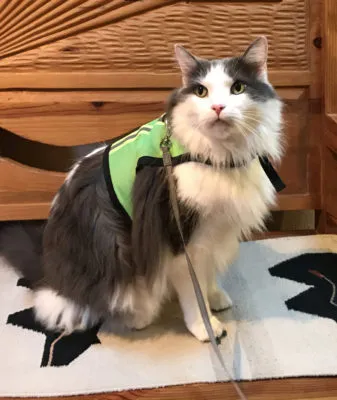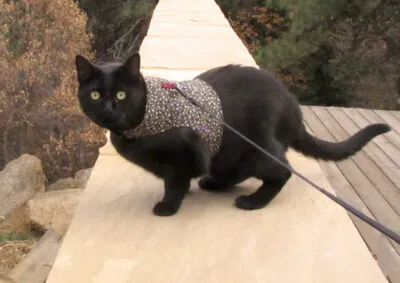Is your curious cat staring longingly out the window or door, dreaming of outdoor adventures? Many indoor cats like Gandalf yearn for fresh air while staying protected from cars, dogs, predators, and diseases. How to leash train your cat offers a perfect solution, allowing safe exploration without the risks. This step-by-step guide draws from expert advice and real experiences to help you train your feline friend confidently.
Indoor living keeps cats safe but can lead to boredom, weight gain, and behavioral issues without stimulation. Leash training expands their world securely, boosting confidence and exercise. For instance, regular walks can turn a restless cat into a relaxed companion. If you’re new to this, check out our guide on how to get a cat to use a cat house for more enrichment ideas.
 Cat wearing a walking jacket outdoors, exploring safely
Cat wearing a walking jacket outdoors, exploring safely
Why Leash Train Your Cat?
Leash training prevents injuries, illnesses, and early death common in free-roaming cats. According to veterinary experts, indoor cats live longer, healthier lives—up to 15 years versus 2-5 for outdoor ones. Yet, without outlets, they may scratch furniture or gain excess weight.
A harness-trained cat enjoys neighborhood strolls, yard time, or deck relaxation with you. This mental and physical activity reduces stress, improves fitness, and strengthens your bond. Well-exercised cats are calmer housemates, less likely to clash with other pets.
 Side view of a cat fitted in a comfortable walking jacket harness
Side view of a cat fitted in a comfortable walking jacket harness
Is Your Cat Ready for Harness Training?
Not every cat suits outdoor walks. Assess confidence first: Does your cat hide from visitors or new objects? Shy felines may panic outside, worsening fears—skip training and enrich indoors instead.
Confident, adventurous cats thrive. They approach novelties eagerly and recover quickly from surprises. Vets recommend starting young, but adults succeed with patience.
Choosing the Right Harness for Cats
Never use a dog collar or harness—cat necks are fragile, risking tracheal damage. Opt for cat-specific walking jackets or harnesses with adjustable neck and torso straps.
Look for snug fits allowing free movement: two fingers between straps and body. Avoid wide collars causing discomfort. Brands like those at Happy Cats Haven offer reliable options tested on rescues.
Test fit indoors: Your cat should walk normally without rubbing or slipping.
Step-by-Step: Introducing the Harness
Patience is key—rush, and you’ll create fear. Use treats, toys, and praise for positive associations. Sessions last 5-10 minutes; stop if frustrated.
- Familiarize: Place harness and leash in your cat’s space for days. Play with straps to add scent and fun.
- Top placement: Lay harness on back for seconds, increasing time. Reward heavily.
- Neck and torso: Fasten neck briefly with treats, then full harness. Build duration gradually.
- Playtime: Engage with favorite toys while harnessed to normalize sensation.
- Pause if needed: Remove if stressed; retry later.
Most cats freeze initially—a predator instinct. High-value treats override it.
Mastering Outdoor Walks
Practice indoors first until movement is natural.
- Start enclosed: Yard or deck, no traffic.
- Carry out initially to prevent bolting. Use treats to encourage steps.
- Follow their lead: Cats explore, you guide safely.
- Position behind/sideways; gentle leash pressure directs.
- Stay close—no tree climbing on leash.
- Scared? Return inside calmly. End with “Home” cue, treat, and harness removal.
Thin, lightweight leashes minimize discomfort. Slack if pulling; praise advances.
 Cat in harness during a training walk, looking curious
Cat in harness during a training walk, looking curious
Train hungry for motivation. Confidence transfers: Your calm demeanor reassures them. Soon, they’ll associate harness with adventures. For counter-training tips post-walks, see can you train cats to stay off counters.
 Cat turning in a harness, demonstrating fit and comfort
Cat turning in a harness, demonstrating fit and comfort
Pro Tips for Success
- Use clickers for precise rewards (see Jackson Galaxy resources).
- Avoid picking up mid-session unless panicked.
- Sessions when motivated: Pre-meal treats work wonders.
- Weather matters: Short, mild outings first.
Real experience: Rescue cats at shelters master this in weeks, enjoying stress-free outings.
Conclusion
Leash training transforms indoor curiosity into safe outdoor joy. Follow these steps patiently for a confident, happy cat. Consult your vet for health checks before starting—tailor to your pet’s needs.
Ready for more? Explore our cat care articles for holistic tips!
References
- Jackson Galaxy: Should You Walk Your Cat?
- Jackson Galaxy: Nine Lives, One Leash
- Happy Cats Haven: Harness training guides and product recommendations
- American Veterinary Medical Association (AVMA): Indoor cat health benefits
